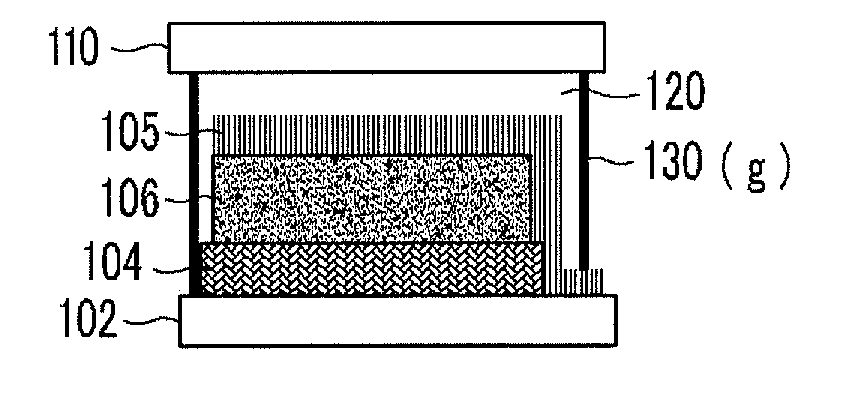Flexible electrodes and preparation method thereof, and flexible dye-sensitized solar cells using the same
a technology of flexible electrodes and solar cells, which is applied in the direction of sustainable manufacturing/processing, nanoinformatics, and final product manufacturing, etc., can solve the problems of remarkably reduced photoelectron transport ability, plastic substrates required for flexible semiconductor electrode fabrication are easily distorted at higher temperatures, and achieve high photoelectric efficiency and high stability of semiconductor film layers
- Summary
- Abstract
- Description
- Claims
- Application Information
AI Technical Summary
Benefits of technology
Problems solved by technology
Method used
Image
Examples
example 1
Preparation of Photoelectrode
[0119]As a substrate of photoelectrode, a glass substrate (thickness: 1 mm) was prepared. Afterward, a metal oxide nanoparticle paste containing 18.5% by weight of titanium oxide nanoparticles (average particle diameter: 20 nm), 0.05% by weight of binder polymer (ethyl cellulose), and a residual amount of solvent (Terpineol) was applied to the glass substrate using a doctor blade. Then, the substrate was heat-treated at 500° C. for 30 min so as to form a porous layer (thickness: 6.1 μm) including metal oxide nanoparticles.
[0120]Subsequently, a transparent adhesive layer (surlyn, bynel, thickness: 25 μm) was layered on the porous layer including titanium oxide nanoparticles, and a transparent plastic substrate (material: PEN, thickness: 200 μm) was layered thereon, followed by hot press using a press machine (top plate / bottom plate: 80° C. / 100° C., pressure: 1 bar). The porous layer formed on the glass substrate, the transparent adhesive layer (surlyn, by...
experimental example 1
[0133]For each dye-sensitized solar cell manufactured in Example 1 and Comparative Example 1, open circuit voltage, photocurrent density, energy conversion efficiency, and fill factor were measured as follows, and the results are summarized in the following Table 1. In addition, the current-voltage curves of the solar cells manufactured in Example 1 and Comparative Example 1, which were obtained under AM 1.5 G and 1 Sun condition, are depicted in FIG. 6
[0134](1) Open Circuit Voltage (V) and Photocurrent Density (mA / cm2):
[0135]Open circuit voltage and photocurrent density were measured using Keithley SMU2400.
[0136](2) Energy Conversion Efficiency (%) and Fill Factor (%):
[0137]Energy conversion efficiency was measured using 1.5 AM 100 mW / cm2 solar simulator (consisting of Xe lamp [1600 W, YAMASHITA DENSO], AM1.5 filter, and Keithley SMU2400), and fill factor was calculated using the obtained conversion efficiency and the following Equation.
Fill factor(%)=(J×V)max / Jsc×Voc×100 [Equatio...
PUM
| Property | Measurement | Unit |
|---|---|---|
| temperature | aaaaa | aaaaa |
| thickness | aaaaa | aaaaa |
| temperatures | aaaaa | aaaaa |
Abstract
Description
Claims
Application Information
 Login to View More
Login to View More - R&D
- Intellectual Property
- Life Sciences
- Materials
- Tech Scout
- Unparalleled Data Quality
- Higher Quality Content
- 60% Fewer Hallucinations
Browse by: Latest US Patents, China's latest patents, Technical Efficacy Thesaurus, Application Domain, Technology Topic, Popular Technical Reports.
© 2025 PatSnap. All rights reserved.Legal|Privacy policy|Modern Slavery Act Transparency Statement|Sitemap|About US| Contact US: help@patsnap.com



